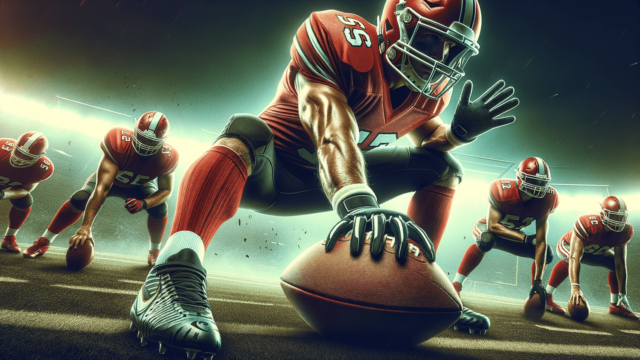
A hot route in football is a pre-designed, quick pass play that the quarterback can call to alter a receiver’s route before the snap, in response to the defensive formation. It helps the offense to counter blitzes and exploit defensive weaknesses.
Understanding the Hot Route Concept
A hot route in football is an in-game adjustment made by the quarterback to change a receiver’s original route, based on the defensive alignment and strategies. It’s an effective way to counter oncoming blitzes, exploit defensive weaknesses, and adapt to varied defensive schemes.
Significance of Hot Routes in Offensive Strategy
Hot routes are crucial for maintaining offensive tempo and ensuring that the quarterback gets rid of the ball quickly in high-pressure situations. Quick passes can neutralize aggressive defenses and thus hot routes have become a vital part of modern football offensive strategies.
Identifying Blitzes and Pressure
Before the snap, quarterbacks study the defensive formation to identify potential blitzes and pressure. If they spot vulnerability, they will call a hot route to take advantage and keep the offense moving. This requires excellent pre-snap reads and communication with the receiver to execute the play effectively.
Adjusting the Receiver’s Route
The quarterback uses hand signals or verbal commands to communicate the hot route to the receiver. It’s important for the receiver to be in sync with the quarterback’s thought process to avoid confusion and execute the play smoothly.
Common Hot Route Patterns
While hot routes can vary depending on the situation and team playbook, some common patterns include:
- Slant: A quick, sharp cut towards the middle of the field.
- Hitch: A short route where the receiver stops and turns back towards the quarterback after a few yards.
- Quick Out: A short route towards the sideline, providing an easy completion to get the ball out of bounds and save time.
- Fade: A deep route towards the sideline, leveraged when a receiver has a height or speed advantage over a cornerback.
Understanding and effectively using hot routes can elevate a team’s offensive flexibility and make it harder for defenses to predict their next move. Quarterbacks and receivers who share strong chemistry and have a deep understanding of the game will be particularly proficient in using hot routes to their advantage.
Executing a Hot Route
Seamless execution of hot routes requires well-timed, synchronized efforts from the quarterback, the receiver, and the rest of the offensive players.
Quarterback’s Role
The quarterback initiates a hot route by identifying defensive vulnerabilities and choosing the optimal route adjustment. Their accuracy and quick decision-making are critical for capitalizing on mismatches and keeping the play alive.
Receiver’s Role
The receiver must pick up the quarterback’s signals and quickly adjust their route as needed. Excellent route-running skills, adaptability, and understanding of the game’s nuances will allow the receiver to turn the hot route into a successful play.
Offensive Line’s Role
The offensive line plays a vital part in hot route execution, as they must provide adequate protection to the quarterback. Quick and efficient pass protection schemes offer the quarterback enough time to make accurate throws.
Hot Routes and Football Terminology
When discussing hot routes and other on-field adjustments, football jargon can be useful in articulating the exact changes being made. Here are a few terms frequently used in relation to hot routes:
- Blitz: A defensive tactic that involves sending additional players to rush the quarterback, aiming to force a hurried throw or gain a sack.
- Coverage: The defense’s responsibility to defend against the pass, typically divided into distinct zones for each player or designated as man-to-man coverage.
- Audible: A call made by the quarterback at the line of scrimmage to change the original play based on the defense’s alignment.
- Cadence: The series of verbal signals used by the quarterback to communicate plays, adjustments, and snap counts to their teammates.
Hot routes are an essential element of football strategy, equipping the offense with the ability to adapt to various defensive schemes. A firm grasp of these concepts and their underlying terminology will help both players and fans better appreciate the intricacies of the game.
Frequently Asked Questions About Hot Routes
After reading our article on hot routes in football, you might still have some questions. We’ve compiled a list of frequently asked questions with concise answers to help you further broaden your understanding of this offensive strategy and its nuances.
Why do teams use hot routes in football?
Hot routes are used to exploit defensive vulnerabilities, adapt to varied defensive schemes, counter oncoming blitzes, and maintain offensive tempo. Quick passes through hot routes effectively neutralize aggressive defenses and provide opportunities for the offensive team to advance.
What are some common hot route patterns?
Common hot route patterns include slants, hitches, quick outs, and fades. These patterns serve various purposes, such as quick completions, sideline throws to save time, or leveraging height or speed advantages by a receiver.
How do quarterbacks and receivers communicate hot routes?
Quarterbacks communicate hot routes to receivers using hand signals or verbal commands before the snap. Effective communication requires the quarterback and receiver to be in sync, understanding the situation and the intended route adjustment.
How does a hot route differ from an audible?
While both hot routes and audibles involve changing the original play, they are not the same. A hot route is specific to altering a receiver’s route, while an audible is a broader change to the entire play, which may involve adjustments to multiple players and aspects of the play.
Do hot routes only apply to specific offensive schemes?
Hot routes are not limited to specific offensive schemes and can be used in a variety of situations, ranging from countering blitzes to exploiting mismatches. The versatility of hot routes makes them an integral part of modern football offensive strategies, regardless of the scheme.
Featured Posts
- No pillar pages found.





